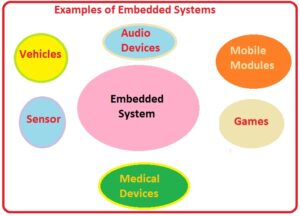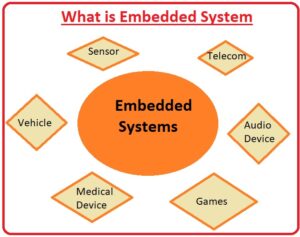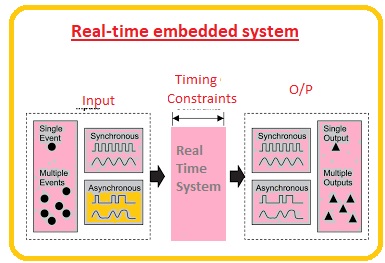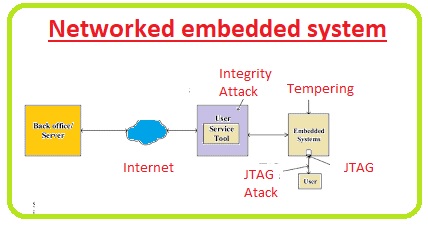 Hello, readers welcome to the new post. In this post, we will discuss Embedded systems. It is a network of computer processors, memory modules, and input-output devices that is based on computers.
Hello, readers welcome to the new post. In this post, we will discuss Embedded systems. It is a network of computer processors, memory modules, and input-output devices that is based on computers.
. In this post, we will learn different types of working and some other parameters. So let get started.
What is an embedded system?
- Embedded systems can be described as the unit of computing that is embedded within another unit of computing or a portion of the computing capacity within a larger computer system.
- The majority of the human-computer interaction is non-software-based. The hardware, peripherals, and software used by the computer user to interact with the embedded system.
- A program is typically a step up from the embedded system software. It is software that uses resources and software components to perform a task.Applications of embedded systems include how they are now a component of every electronic system.
They are utilized for virtually every sort of electronic control, including power supply, on-board diagnostics, and vehicle control systems.
How do embedded systems work?
- It has been a tradition in the electronics industry to provide a software toolset that controls and monitors an embedded system, as well as provide additional features like new peripheral devices, extra memory, and multiple functions.
- However, there is a valid reason why hardware-based design and implementation of embedded systems is still required.
Embedded devices contain a computer processor, memory, input/output peripherals, and control interfaces to interface with physical devices, the user, and the host machine. - This type of hardware provides a lot of features that the software simply cannot emulate, as software is typically not designed to control and interpret the microprocessor instructions. An embedded system is an example of what is called a “cross-platform” system.
What are the advantages of using embedded systems?
- An embedded system can be built into a machine to support a particular function that is not part of the main controller. This part, which is separate from the rest of the primary system, aids with the system’s flexibility and scalability.
- Another advantage is that the cost of developing an embedded system has reduced over time as companies are offering embedded systems as a standard product to their customers.
- Another advantage embedded systems offer is that they can be more fault tolerant and therefore perform better.
- What are an embedded system’s primary components?
? Embedded system components include a computer, memory, and peripheral devices. The most fundamental element of an embedded system is a microprocessor.
Where do you see the future of technology?
- “The future of technology is in ‘things’. Humans will share the planet with robots—yes, really—and the value they will create together will be the main driver of how our lives evolve.”
- I believe I have a solid knowledge of the potential and difficulties associated with embedded systems because I spent my childhood around electronics. As electrical, mechanical, optical, and software (EMOS) technologies converge, I see a time when embedded systems will be crucial to the realization of our digital society.
Examples of Embedded System
The common examples of this system are explained here.
Real-time embedded system:
- This category of embedded system is employed in different categories of serious conditions where certain control is needed
- Such as in military uses, medical devices and different types of machines control in the industry.
- The expert and manager of this system is very demanding jobs since they are highly professional and skilled and know how to manage the system
- Some parameters are taken into consideration during construing of this system such as circuit analysis, different designs, testing, etc.
- The component used in the system should work accurately for large time intervals to avoid any hindrance.
- Common applications of this system are regulation of heat, escalators controls of light.
- Robots are also assembled on the basis of this system.
- Different communication systems such as radio, satellite-based on the real-time embedded systems.
Standalone embedded system:
- This embedded system operation is based on its internal configuration since not linked to any other device or processor.
- Its data-taking type is an analog and digital signal.
- Its operation is such that obtained data in form of a digital or analog system is processed then transform in the output and display at the screen linked to it.
- The practical examples of standalone embedded systems are listed here.
- Oven
- Audio players
- Camera
Networked embedded system:
- Its configuration is such that linked to a string system that get the output from this system
- All the modules in the network-embedded system link to the network through different linking devices.
- Commonly used networks are LAN or WAN. LAN covers the small area and WAN configure to a larger area.
- The connection among the devices linked to the system are wireless as well wired.
- It is now very commonly used due to its high-speed operation.
Small-scale embedded system:
- This network comprises of eight to sixteen-bit microcontrollers. So used to do the operation at a basic level.
- It comes with the RAM and ROM assembled on the system.
- Its operation is done through the use of a battery.
Conclusion
Many times, you may want to be a part of the upcoming electronics revolution, so get involved! Remember: What you do to make changes in lifestyle in the future What is embedded technology? It surrounds us and will have a significant influence on your career.
Knowing how your knowledge and experience fit into the current technological era is a terrific approach to get ready for what is ahead.









